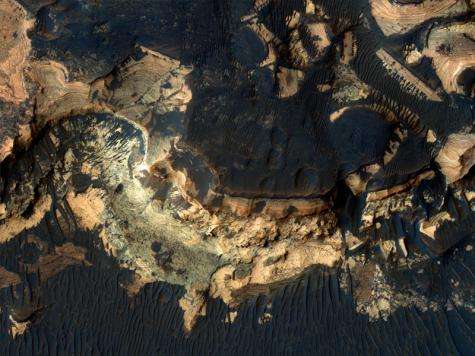Vast areas of low latitude subsurface ice found on Mars

There could be more subsurface ice on Mars than previously thought, and vast stretches of it may lie just south of the equator. Indeed, one of the proposed landing sites for the Mars Science Laboratory could hold the mother lode of enticing scientific prospects. Observations from two spacecraft, the Mars Reconnaissance Orbiter and Mars Express, have revealed potential subsurface ice deposits in areas just south of the equator, including one near Holden Crater, with an estimated reservoir of perennial subsurface water ice of about 50 – 500 kg m-2 just two or three meters beneath the surface. This is the first evidence of ice at “tropical” latitudes on Mars as low as 25 degrees.
In 2009, MRO observations revealed water ice as low as 45 degrees North in a recent small impact crater, and permanent water ice at Mars’ poles is known to exist. But most robotic missions – and hopefully one day human missions – need to land closer to the equator to meet safety criteria and engineering constraints. As evidence, the four proposed landing sites for the MSL hover within 25 degrees of the equator.*
Of course, subsurface ice can’t be seen directly on Mars, but certain surface characteristics and thermal properties belie potential underground ice. The OMEGA (Observatoire pour la Minéralogie, l’Eau, les Glaces et l’Activité ) onboard Mars Express and CRISM (Compact Reconnaissance Imaging Spectrometer for Mars) onboard the Mars Reconnaissance Orbiter use near-infrared imaging spectrometers to measure solar radiation scattered by the surface, providing spectral images that have been used to assess the composition of both minerals and condensates on the surface of Mars.
What drew scientists to this region, were observed surface distributions of seasonal CO2 frost on pole facing slopes. Carbon dioxide ice usually only forms on the surface if there is a cold layer beneath, which can come from water ice or bedrock.
But in this case, Mathieu Vincendon and his team at Brown University concluded that bedrock couldn’t be responsible for creating the observed thermal properties that stores and releases heat two or three meters beneath the surface. Evidence of a uniform layer of bedrock stretching across the equatorial region has never been seen in orbital images, which would have been revealed by erosion or impact processes.
“Using different modeling hypotheses within the range of uncertainties leads to the result that water ice is present within one meter of the surface on all 20-30° pole facing slopes down to about 25°S,” the team writes in their paper. “ The relevant thermal depths probed are 2 or 3 meters. Hence, an ice rich layer that thick is implied, which leads to an estimated reservoir of perennial subsurface water ice of about 50 – 500 kg m-2 on steep slopes.”
The team believes that the subsurface ice could be possible remnants of the last ice age on Mars, and could provide water that will be needed for the future exploration of Mars. More thermal measurements of seasonal temperature variations could help to derive more precise permafrost depths.
Holden crater is located at the edge of the subsurface water ice area at 26°S.
*Eberswalde Crater is -23.90 degrees S, Mawrth Vallis is 23.99 degrees N, Gale crater is -4.49 degrees S, and Holden is -26.4 degrees S.
Source: Universe Today





















